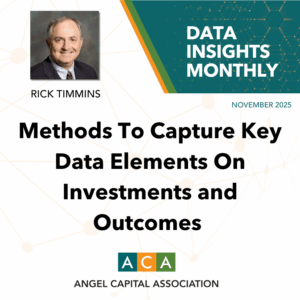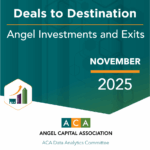The purpose of this Data Insight is to share ways that angel groups have utilized to collect key elements of their group’s investments and outcomes. We recognize that this can be very challenging for many groups that have limited resources and time for this work, but there are many approaches to make this less daunting. Hopefully, after reading this insight, you’ll come away with a few ideas that can make it easier.
In the October Data Insight, we explained the importance of collecting key data elements within an angel group, in order to answer the following kinds of questions and then share the learnings with members:
- How long should I expect it to take to start seeing exits?
- How many companies do I need to invest in to achieve some sort of reasonable return?
- Which industries are most likely to yield the best exits?
- How do local outcomes compare to other geographies?
- What is the appropriate pre-money valuation for certain vertical industries?
- Is there wisdom in “following the crowd” of my fellow investors?
- Are patterns emerging that point to more successful investments compared to others?
- What are the expected returns of successful angel investing over time?
- Am I better off investing in Convertible Notes or Preferred Equity?
- How do returns differ for new rounds vs follow-ons
- What sorts of experience or background in the CEO is more likely to lead to successful outcomes?
Below is a graph that shows the percentage of angel groups that collect investment and outcomes data and report it on an annual basis, broken out based on the size of the angel group. No surprise that 74% of the larger groups (over 150 members) track their data. 64% of groups with 100-150 members and 59% of groups with 51-99 members also track and provide their data. However, only 29% of groups with fewer than 50 members track and report their data. Clearly there are challenges with this work for smaller angel groups. Below we will try to provide suggested solutions for all groups to collect and provide their data to the ACA, but more importantly to their own members.
FIGURE 1: ANGEL GROUP DATA COLLECTION EFFORT BY GROUP SIZE

Source: Angel Capital Association and submissions for the Angel Funder Report
Within the ACA, 53% of groups are a network where members invest individually into companies, 11% are a fund where members contribute to the fund through which the investments are made, and 37% are a combination of a network and a fund. Admittedly, it is much easier to track investments and outcomes when an angel group utilizes a fund, and a process is in place to decide if the fund will make the start-up investment. We are not advocating that all angel groups should utilize a fund, but rather simply note it is easier to track investment and outcome data of a single entity (the fund) over which the group has management oversight, as opposed to individual members’ investments. From the perspective of the company receiving the investment, one fund on a cap table is easier to track compared to potentially many individual/entity names on a cap table.
There are three big challenges preventing all angel groups from collecting their group’s data:
- Time—This is undoubtedly the biggest issue. Many angel groups do not have paid full-time or part-time resources.
- Implementation—People do not have the knowledge as to how to get this process started or maintained.
- Organization structure—The angel group is not organized in a way that is conducive for efficient collection of data.
For the last six years, the Angel Capital Association (ACA) has published the annual Angel Funders Report based on data collected and submitted to the ACA by member angel groups. Approximately 70-75 angel groups are providing their investment data elements and outcomes each year. The ACA has prepared an angel group tracking spreadsheet (in Excel) covering ~25 data elements on each investment and ~15 data elements on angel group outcomes. Click here for the tracking and reporting spreadsheet with these data elements. ACA has also created a web form that allows groups to add information as the year progresses, and some groups find this preferable. A link to that web form is here. These tools can serve as a good out of the box solution for any group seeking to track its data and outcomes.
If an angel group is large enough, full- or part-time resources can be utilized to capture this data. If these resources are not available, then a volunteer or volunteers from an angel group can be secured by the leaders of the angel group through a reach out process to its members. Based on feedback that angel groups have provided to us, tracking and reporting approximately 15-20 metrics per year with 50-100 angel group members requires approximately 40-45 hours per year or around 4 hours per month. These numbers can increase or decrease based on the number of members and also the number of metrics the group strives to track. It can be less, when their portfolio CEOs are given the primary responsibility for providing the data. While many angel groups cannot track all of the investment criteria contained on the ACA tracking spreadsheet due to the three constraints noted above, many angel groups have adopted methods to collect a subset of this data even with no full-time or part-time headcount resources. Knowing the importance of collecting their own investment and outcomes data, here are several ways angel groups without full-time or part-time resources told us they go about it:
- Most angel groups use commercial deal-tracking software for their deals and engagement with their members. Some of the data needed can be extracted directly from these platforms, and, in fact ACA is working with several of the vendors to make that process easier. Using these platforms, a volunteer can identify the members who are interested/investing and load the information into the deal-tracking software. The volunteer can then reach out to members or the entrepreneur to capture missing data elements they choose to track on an investment and eventually on all outcomes (shutdowns and exits).
- Many angel groups simply create a spreadsheet of these key data elements they wish to track and ask for (or appoint) a member “ambassador” for each investment and ask the ambassador to work with the entrepreneur/CEO or other members investing in the company for the data elements. Often, the Due Diligence Lead serves in this role. These company ambassadors can stay with the company even if they should resign from the angel group, although admittedly that does not always happen.
- There are also angel groups that have developed easy-to-complete web forms, e.g., Survey Monkey, that are sent to the entrepreneur/CEO requesting them to provide the key data elements being tracked by the angel group. This is done after each round has closed. It takes on average only seven minutes for the entrepreneur/CEO to complete this form (which is usually much less time than trying to gather the information from members). The responses from entrepreneurs/CEOs are then downloaded and transferred into a Google Sheet or Excel file. If your group has a paid Survey Monkey account and wants to utilize this approach, please let John Harbison) know and he will send you this template).
- Several angel groups send out messages to all members on a quarterly basis or twice a year, asking them to provide to a volunteer member of the group the investments they have made within the angel group in that particular quarter or half of the year. Once the investments are provided to the volunteer, he/she will then engage with a member “ambassador” for that company to obtain the key data elements the group is tracking, including outcomes, and maintain this data on a relatively simple tracking spreadsheet
- Another option is to utilize an in-house developed webform to collect soft-circles and actual investments by members. This is then turned into a spreadsheet and loaded into an investment tracking tool such as Seraf. Organizations then reach out to the invested company to obtain a post-close cap table to verify all investment data. A spreadsheet can then easily be utilized to maintain tracking of the key data elements they wish to track on investments and outcomes. Groups are also creating an internally developed data collection platform for data collection, storage and manipulation of the data.
- A few organizations have created a multi-class LLC for each deal. Members receive one K-1 per year that represents all of their investments. For each deal/investment, there is a deal lead who provides key data elements for each investment, including outcomes data to a volunteer within the angel group. This approach can help, although there is a cost of setting up and administering LLCs.
- A new and innovative approach is to use AI software to collect key data elements on group investments. For example, ask ChatGPT “For each of the following companies, identify the name of the CEO, his/her LinkedIn profile page URL, and whether the person had CEO experience prior to becoming CEO of that company? Can you present this response in tab separated table that can be cut and pasted into an excel file?” It doesn’t work for some data elements (such as amount of investment or valuation), but for many of the other elements it works well.
Finally, once this data is collected, volunteer members can summarize this data into many important data points that can then be shared with members of the angel groups on an annual basis. This type of presentation allows members to see what is working in terms of returns and frankly, what is not working. Collecting this data and sharing it with members provides the angel group with a significant educational best practices that works to help ensure that angel investing can be successful for its members. This data can also be benchmarked to other angel group metrics that are already tracking investments and outcomes data, and groups that submit their data to ACA for the Angel Funders Report, are given a PowerPoint deck with all the AFR slides which then can be modified to use as benchmarks.
We hope this data insight has provided you with suggestions for getting started in collecting data associated with angel group investments and outcomes. Feel free to reach out to me for contacts of people who can assist angel groups that are interested in learning more about collection methods or general questions associated with this activity. The ACA wants to help angel groups’ efforts to collect their data on an annual basis and be part of the annual ACA Angel Funders Report (AFR). The link for the 2025 AFR is here.
Key Takeaways
- An angel group that understands the importance of collecting data on their investments and outcomes can and should find resources to assist in this work.
- The effort is not as resource intensive as it may seem. Many processes available to do this work, as discussed above, can take 4 hours to 10 hours per month, depending on the size of the angel group and the number of investments and outcomes that occur within an angel group.
- Angel groups that track and analyze investments and outcomes position themselves to become better investors and increase member engagement and retention.
About the Author:
- Rick Timmins, ACA Data Analytics Committee Member
Central Texas Angel Network (CTAN)






